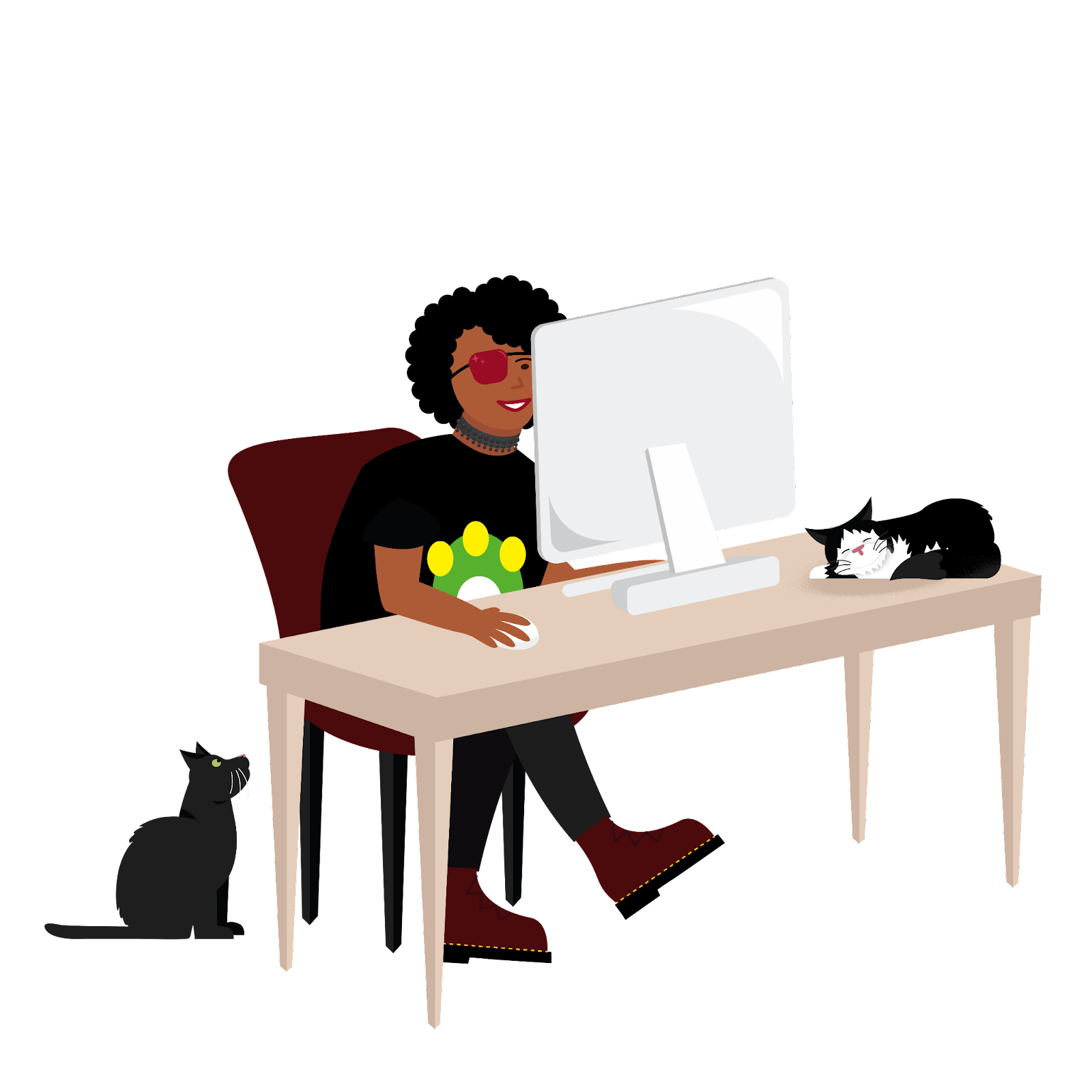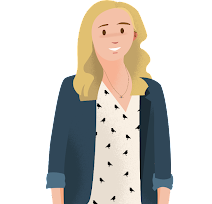Learn the Importance of Accessible Communications
Learning Objectives
After completing this unit, you’ll be able to:
- Describe why accessible digital content is important.
- Define accessible communication.
- Understand the difference between legal requirements and best practices in accessibility.
Understand Accessibility
Imagine going to a website to make a purchase, only to find all of the product images are missing. Or imagine your boss sending you an essential report to review for work, only to find that all of its charts were solid black boxes. What if you were asked to watch a safety-related training video, only to find it had no audio? You’d find it pretty difficult to get the information you needed in those conditions, right?
Unfortunately, that is the experience offered to your colleagues and customers when you don’t think ahead to plan and create accessible content. Unusable websites, unreadable reports, and unwatchable videos.
Have you ever wondered what a non-accessible website offers to someone who accesses it via screen reader? In this recording, Crystal Preston-Watson, senior digital accessibility analyst at Salesforce, lets us hear how a page not designed with screen readers in mind sounds to her.

Click here, as the audio should provide a fairly simple weather update. Instead of simple, someone using a screen reader will hear:
“Link forecast link any level for cold front springs SDTV storms Friday cooler weekend highs reach the mid eight zero S for another day before dropping into seven zero S for the weekend. Link Biden architect link link elites trail of devastation through Florida Button. Button. Button. Button. Button. Button. Button link, link privacy. Button you're currently under button Link. Link privacy. Link go to footer. Link. The US states people are fleeing in the West blank link sponsored link link”
Why Is Accessible Content Important?
Whether you’re trying to sell products and services, educate readers, or inform and persuade people to take action, your goal as a communicator is to reach as much of your target audience as you can. However, when you create non-accessible content in any media, you’re excluding an ever-growing part of your potential audience, and creating unnecessary barriers to their interaction and engagement with the world.
Accessible communication is the sharing of information that is easy to understand and has been made available in various formats so that everyone has equal access.
Communicators must take into account common barriers to both physical and neurological accessibility in communication. These include, but are not limited to:
-
Digital graphics without alt attributes describing the content: People with visual impairments use screen readers, which can’t convey any content that is not text-based.
-
Audio and video files without subtitles or accompanying transcripts: People who are deaf/hard of hearing cannot follow a video without subtitles, or get content from an audio file without a written transcript.
-
Web pages that require a mouse or other pointing device to navigate: Many users with motor disabilities rely on a keyboard for website navigation.
-
Content presented in only one format: Neurodivergent individuals may relate better to video tutorials rather than text-based instructions, or vice versa.
Consider the experience of Amy Wood, accessible events program manager at Salesforce.

"When podcasts first exploded in popularity, I wasn't really that interested. Being deaf makes it difficult to understand the dialogue, and the podcasts often didn't provide transcripts. But podcasts became so mainstream that all my friends and family were discussing their favorite one, especially the 10-part murder mysteries that sounded really engrossing. I could not participate in those conversations with my friends because podcasts were not accessible to me." —Amy Wood, Accessible Events Program Manager at Salesforce
So, how much of your audience could you be excluding by not creating accessible content? Exact worldwide figures are hard to come by due to differences in data collection. But using the United States as an example, more than 25% of American adults live with a disability (as of 2024), and more than 40% of those over the age of 65 live with a disability. Additionally, it is projected that, by 2034, the population over 65 will outnumber children for the first time in history. Assuming these figures are roughly equivalent worldwide, the percentage of the population that needs accessible content is substantial and will continue to grow.
Global Numbers: According to a WHO and World Bank Report, globally there are around 785–975 million persons 15 years and older living with disability (16–19%). Including children, over a billion people (or about 15% of the world’s population) were estimated to be living with disability.
An ever-increasing amount of day-to-day activities are now managed online, via websites, apps, and mobile devices. You use apps to order groceries or dinner, you use smartphones to get directions and navigate routes while driving, walking, or on public transport. There’s an app for everything, and most of us use them without thinking much about them. However, people living with a disability have much lower rates of technology adoption.
Fifteen percent of Americans living with a disability reported that they never go online, compared with just 5% of those without a disability, according to a 2021 Pew Research Center survey. That same survey found that those living with a disability are also less likely to own a smartphone, laptop, or tablet.
As the shift toward a digital-first world continues, the mindset around content creation shift. It’s a must that everyone has equal access to the resources that the world offers. And fully accessible communication is an essential component of this.
Define Disability
So when you hear about “people living with a disability,” who does that mean? Well, many of us, it turns out. Whether through aging, illness, or injury, it’s extremely likely that many of us will experience either a temporary or chronic disability at some point in our lives.
The term “people with disability” describes a diverse group of individuals with differing levels of ability and different requirements to make communications accessible for them.
Additionally, some disabilities can be hidden or not easy to see. As Amy Wood, accessible events program manager at Salesforce, puts it: “My hearing aid is not always easy to see, so people can be unaware of my disability. They will get frustrated with me if I don't hear them say excuse me. Or, they will call me names because I appear to be ignoring them, when in actuality I just cannot hear them.”
Because Amy is an oral deaf person, she says it can also be easy for people to forget the level of accommodations she needs in order to participate in different activities.
“People will turn their head while talking, forgetting that I need to lipread, or forget to enable captions in a video so I can follow along."
Tom Frantz, senior manager of Accessibility Partnerships and PR at Salesforce, has a different non-apparent disability: ADHD. He shares his experience in the video.
Building a world with accessible content as the default is the right thing to do in order to ensure all people have equal access and opportunity. And it also eventually may benefit you, or someone you care for.
Laws vs Best Practices Surrounding Accessibility
The landscape of disability rights and the evolving awareness of existing systems that exclude portions of the population is continuously expanding and rapidly evolving. There is a significant gap between what is required by law in various jurisdictions worldwide versus real-life best practices.
Interested in accessibility laws in your part of the world? Disability:IN offers a resource for finding which laws are applicable in various countries.
Our focus as communicators should be on following best-practices as identified by affected groups, rather than focusing only what is required by law. Legal requirements are the baseline, but there are many more ways in which you can expand the accessibility of your communications and move beyond mere compliance with the law.
Haley Kimmet, access program manager at Salesforce, says this: “My biggest struggles with accessible content have been with people making assumptions about what works best for me based on the fact that I've identified myself as deaf/hard of hearing. I think the most important feedback is for content developers to recognize there is huge variation within subsets of our disability communities and not to assume that one size fits all.”

According to Haley, technical innovations such as auto-captioning have been a double-edged sword. “It’s a cool advance in technology that can create better access, but it also misses out on subtleties of communication, and it doesn’t capture the nuance offered by non-speech information, like tone of voice or expression,” she says. “But because it’s available, organizations perceive that it has solved everyone’s problems, and they don’t maintain accountability for true accessibility.”
Haley also calls out that planning for accessible content is an excellent way for organizations to set themselves apart. For example, Salesforce partners with 3Play Media, a vendor that handles embedding captions and transcripts in some of our content. Companies like this make it easy for organizations to keep their content accessible for everyone.
Mainstream media is also making the shift to accessible content for all content. Vox Media, for example, released an immersive podcast with Mandy Harvey that is accessible to deaf audiences. As Haley says, “Accessibility is innovation. It's the future, y’all!”
Clearly, it’s everyone's responsibility to work to understand the preferences of groups and individuals regarding what types of communication work best for them. Learn more on this topic in the next unit.
Resources
- Website: Americans with Disabilities Less Likely to Own Some Digital Devices
- Website: CDC Data Shows Over 70 Million U.S. Adults Reported Having a Disability
- Website: Toward a Common Language for Functioning, Disability and Health
- Website: Effective Communication
- Website: 3Play Media
- Website: “More Than This”: Episode One
